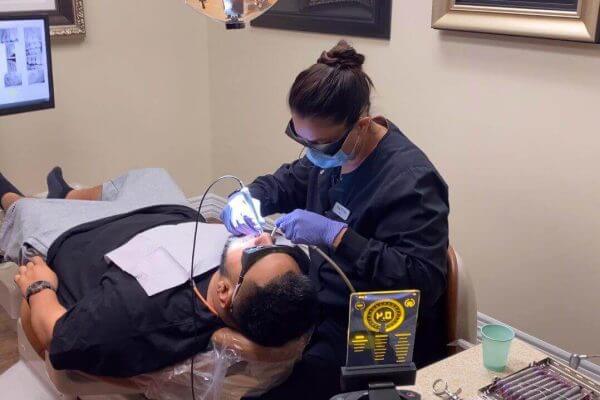What Causes Bleeding Gums When Flossing?
When most people think about dental health, plaque buildup and cavities are the first thoughts that come to mind. However, it’s important to think past the teeth and focus on the gums, as well. Gums play an important role—not only for dental health but also for overall wellbeing.
Often, bleeding or swollen gums are signs of gum disease, but there are all sorts of problems that could cause these symptoms. If you notice irritation or any other dental issues, contacting a dentist can prevent small problems from turning into major health risks.
Cosmetic dentist Dr. Derek B. Hauser, DDS, has been serving Riverside County for more than 20 years. He is known for educating families on dental hygiene while providing modern, comfortable treatments. If you’re looking for a way to treat red or swollen gums, Contact Lakefront Family Dentistry at (951) 244-9495 or Request an Appointment Online Today!

Brushing Technique
Some patients think by brushing vigorously, the teeth will be cleaner and the gums healthier. Though this certainly seems logical, brushing hard and fast is not the way to go. Gums comprise very delicate tissue, so brushing profusely could damage them.
When choosing a toothbrush, whether it’s an electric or manual design, patients should select a soft, nylon-bristle brush. Hard-bristle brushes may damage the enamel on the teeth and can cause swollen or red gums.
While brushing, it’s important to use gentle, circular motions to clean and massage the gums and teeth. Many people use a back-and-forth technique, but this can damage and irritate the gums, which makes them sore and more likely to recede or bleed.
Bleeding Gums When Flossing
Flossing is an important part of a responsible dental routine. Patients should floss daily to remove plaque and bacteria from crevices the toothbrush can’t reach.
Remember to floss gently, as this is the key to preventing bleeding gums when flossing. To ensure a thorough cleaning, cautiously slide the floss up and down to enter teeth crevices, following the curve of each tooth.
Gum Disease
Three-quarters of American adults older than 35 have been diagnosed with periodontal disease. Most diagnoses are of the less severe form, called gingivitis, but between 5 percent and 15 percent of those people have a more severe type of gum disease, known as periodontitis.
Irresponsible dental hygiene may lead to periodontitis, which is characterized by bacterial infections in the mouth and more plaque on teeth. Bacteria cause gum inflammation, which may result in swelling or bleeding.
Often, gingivitis is not painful, and many patients are unaware they have it. If you’re unsure, here is a list of symptoms that signify the need for medical attention:
- Noticeable changes in the way teeth fit together
- Deep pocket formation between the gums and teeth
- Bleeding gums during or after brushing or flossing
- Shifting or loose teeth
- Persistent halitosis or a bad taste in the mouth
- Receding gums
- Tender, swollen or red gums
As gingivitis progresses, periodontitis may develop. Periodontitis is a condition in which the bone and gums that hold the teeth in place become weak. As well, bacteria release toxic substances that harm the gums, causing them to become irritated.
Risk factors of periodontal disease include:
- Diabetes
- Smoking
- Poor oral care
- Heredity
- Stress
- Crooked teeth
- Medications that cause dry mouth
- Female hormonal changes
When the body attacks bacteria, patients may notice inflammation and signs of infection. Eventually, the jawbone and gums may begin to deteriorate. If left untreated, periodontitis can cause tooth loss.
Visit Dr. Hauser at Lakefront Family Dentistry to Reverse Gum Disease
By conducting an in-house deep cleaning, Dr. Hauser can treat gingivitis. To make sure patients have a comfortable experience, a local anesthetic may be administered for relaxation.
During a deep cleaning, one of our highly trained, registered dental hygienists will remove tartar and plaque buildup from below the surface of the teeth and on the tooth enamel. Once all plaque has been removed, we smooth the tooth roots to extract hidden, infectious bacteria. In the end, your mouth will be healthier and cleaner. As well, you may notice improved breath and less oral irritation.
If you are in need of an amazing cosmetic or family dentist, Contact Lakefront Family Dentistry at (951) 244-9495 or Request an Appointment Online Today!





